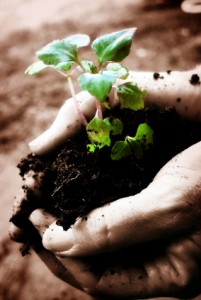 Volumes have been written about soil classification and competing systems have been devised for different purposes. The prevailing system in the U.S. includes some 13,000 “series”—roughly comparable to species in biology—grouped into 11 soil orders. You may not need to start with that level of detail if you want to go “back to the land”, but there are some immediate questions you’ll need answered about just what type of land you’ve gone back to:
Volumes have been written about soil classification and competing systems have been devised for different purposes. The prevailing system in the U.S. includes some 13,000 “series”—roughly comparable to species in biology—grouped into 11 soil orders. You may not need to start with that level of detail if you want to go “back to the land”, but there are some immediate questions you’ll need answered about just what type of land you’ve gone back to:
- Where and what can I grow?
- What do people mean when they talk about soil types?
Dirt is Dirt, Right?
We probably need to start by specifying what we mean by soil. Some sources use the term to refer to only the mineral content—basically powdered rock—of that stuff on the ground. While it’s true that some soils may contain virtually no organic matter, they’re not generally useful for growing, and outside the scope of this article.
The Master Gardener manual from Cooperative Extension at the University of Arizona gives a more practical definition for our purposes:
Soil – The unconsolidated mineral and organic matter on the immediate surface of the earth that serves as a natural medium for the growth [of] land plants.
Five types, Two criteria—and Why You Should Care
When people talk about soil types, they generally mean one of five descriptions that fall under two unrelated criteria:
Texture is determined by the kinds and proportions of mineral and organic content:
Sandy soil
- Large, coarse particles, visible to the naked eye
- Rough or gritty to the touch
- Does not cohere when you squeeze it in your fist
- Generally light-colored
- Admits water but doesn’t retain it
- Requires intermittent, relatively frequent watering
Clay, silt
- Powdery particles (silt); a compact mass (clay)
- Smooth to the touch; when wet, slick and sticky (clay) or slippery (silt)
- Sticks together when you squeeze it, changing shape but not volume, and holds its shape when you release it
- Retains water and nutrients so well it may withhold them from plants
- When dry, resists water, which may pool on the surface and compact the soil
- Requires sparse, intermittent watering if any
Loam
- Loose, visible, particles, possibly irregular in size and shape
- Feels like potting soil or garden dirt
- Coheres when you squeeze it, then crumbles when you release or poke it
- Dark and rich-looking
- Generally absorbs, stores, and releases water well
- Specifics of water transfer depend on whether the mineral component is mostly sand or clay; a sandier loam is preferred for most growing.
Acidity is measured on 14-point pH scale, where 7 is neutral.
- Lower pH values indicate acidic soil
- Higher pH indicates alkaline soil
Different plants have different requirements for acidity or alkalinity.
The range from 6.5 -7 is variously called neutral or mildly acidic.
Few plants can grow in soil with a pH below 3.5 or above 8.5.
Rainwater is naturally acidic, and growing more so as atmospheric carbon dioxide increases.
Rain in the western U.S. is generally more acidic than rain in the east.
Observation is Your Ally!
As noted, texture can easily be tested by look and feel. Acidity testing is usually done with kits available at a nursery or in the pool supply aisle of a hardware store. (Testing at the outer edges of the scale can be done with vinegar and baking soda to determine if more precise tests are needed.)
To at least some extent, you can infer soil texture and chemistry from what thrives on your property now. Wild nasturtiums, for example, while not too particular, are known to prefer a sandy, alkaline soil, which will cause them to produce the most blossoms; if they are growing very greenly with little flowering, their location may be loamier than they “like”—not optimal for them, but indicating good texture for other plantings, and that the soil might need to be acidified for other plants to thrive.
What Else Do You Need to Know…?
Other significant characteristics of soil have more to do with environmental conditions or history (the types above don’t always predictably correlate to environmental factors, and will likely vary across even small plots of land). These further classification methods may also be thought of as external factors the grower responds to—and may be able to alter—more or less independently of whether soils are sandy, clayey, loamy, acid or alkaline:
- Compaction happens. You can test for large compacted areas—“hardpan”—by walking your land with a piece of rebar or other metal rod; you should be able to insert it with relative ease to a depth of 6-8”. Roots of plants you pull will also tell a tale: expect them to be white and vital-looking, with good spread and depth. If very shallow, squishy or brittle, black or gray, they’ve been malformed by compacted soil or a high water table, and infected with rot. Tilling breaks up and aerates compacted soil; a combination of tillage and appropriate, well-tended plantings will help maintain your soil in a healthy state.
- Structure and (untended) moisture are additional factors in determining the mode and effectiveness of watering.
- Profile (the depth and character of topsoil and subsoil) may determine whether deeper- or shallower-rooted plants are more suitable in a given area, or whether raised beds are advisable.
- Temperature varies according to sunlight and other factors, determines growth rate, and may also influence irrigation strategies.
…and How Do You Know it?
Tests for these factors, as well as for texture and acidity typing, can be readily performed onsite with a shovel; a thermometer; an oven, hot plate, or other apparatus for drying just above the boiling point; water; a coffee can, a jar, a yardstick or ruler, a gram scale, and a propane torch. (Rain.org gives directions for all these tests. The page mentions a specialized soil core sampling tool for examining soil profile; you can buy one, try to make one, or simply dig a hole with a sharp vertical side and take a slice off that side with a shovel.)
Is That it?
Of course not, as any farmer can tell you. Raising our eyes to and above the horizon, we see slope, weather and climate—rather harder variables to wrangle. And in living systems, there may be a new contingency each day.
A baseline knowledge of soil texture, chemistry, and structure will at least give you a head start for what might work or fail in your environment. A companion piece to this article will address how to respond to the conditions you find, along with some special problems, and even some benefits, from atypical soils. Look for it soon.
If you liked this article you may be interested in this product from our sponsor.

 Off The Grid News Better Ideas For Off The Grid Living
Off The Grid News Better Ideas For Off The Grid Living



